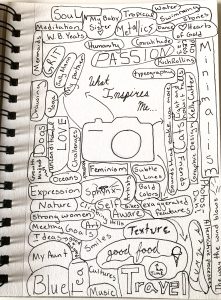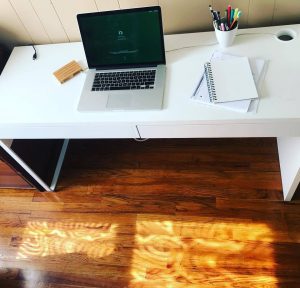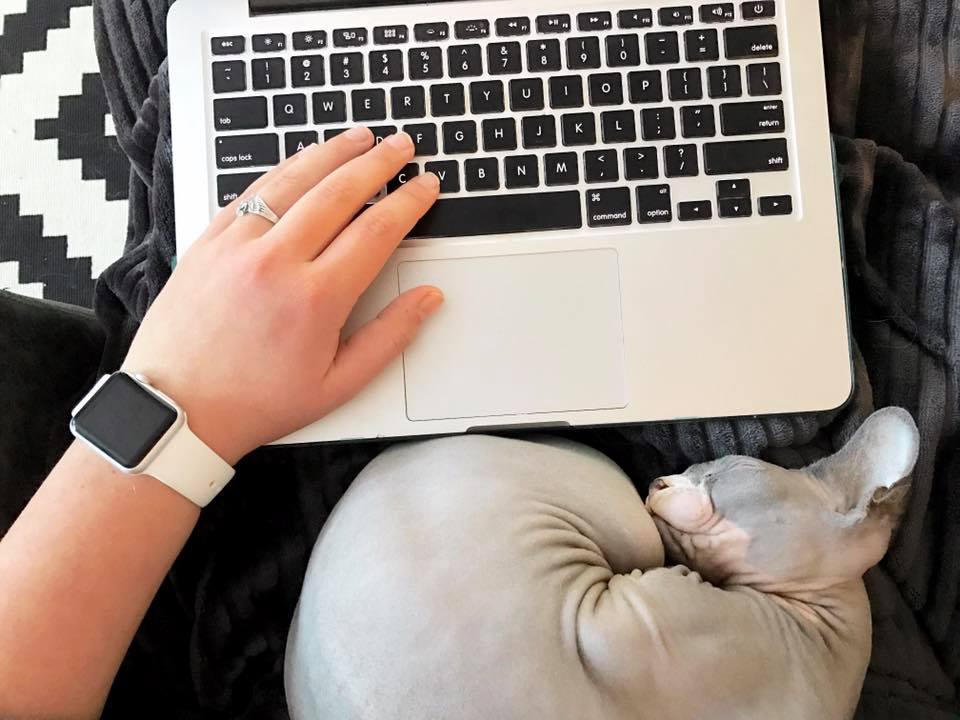Writing about art can daunting. After all, aren’t we creating work to communicate in a visual way? Finding the right words to describe art work is like looking for the wind sometimes. Ever changing and invisible. However, the wind has some major impacts- we can see its shifts in other ways. This is how we have to look at examining our own work- the subtleties.
Thankfully, I had 5 years in art school that taught me writing about art was not only a challenge but also essential. Compelling work will ask for more- including those magic words that describe your work.
What is perhaps even more of a challenge for some of you will be narrowing down words to describe your work. I know this is the case for me, since I am inspired by so many things- see the image of my ‘Inspiration Web’ below. All of these pieces are true inspiration, but not all of them are evident in my work.

The Exercise
Step 1: Gather and Observe
You need to be looking at something in order to decide the words for your work. So, gather some of your favorite pieces or alternatively look at you Instagram or Website Gallery. Spend at least 10 minutes if not more scrolling through your work.
Now grab out a piece of paper or your journal to start some brainstorms.
Step 2: Decide what Elements of Art or Principles of Design are most prevalent
Elements of Art are the foundation building blocks for composition and how we choose to arrange elements in the frame. It is important to recognize that these are conscious choices and not random (even if some artists prefer to think this way). You brain is constantly processing visual information and making choices about it.
Elements:
- Line
- Color
- Texture
- Shape
- Value/Contrast
- Form
- Space
Principles of Design are the general ideas about HOW you arrange the elements. These are often intertwined with your theme.
- Balance
- Unity
- Variety
- Emphasis
- Movement
- Pattern/Repetition
- Proportion/ Scale
- Rhythm
After looking at both of the lists- narrow down the elements or principles most evident in your work. You list should include about 5, but no more than 8. Keep it precise.
Step 3: Consider Moods and Themes
Mood is created by one of two things: lighting or subject. Cliche mood images with light are things like a sunrise or sunset. However, lighting such as fog or bright harsh light can create different moods. Subject created mood depends on the viewers relationship to it. For example, a puppy can bring a joyful mood while a lone park bench can bring a solitary mood.
Mood is the viewers feeling to your work. Tone is your own (the photographer’s) attitude regarding the subject. So try to keep these separate and examine your work from he viewers perspectives.
To get you started here are a few Mood Words: (Some of they may apply, but don’t hesitate to Google a mood word list)
- Abandoment
- Vulnerable
- Intimate
- Harsh/Removed
- Energetic
- Judgmental
- Observant/Voyeuristic
- Proud
- Provocative
- Respected
- Worthy
Themes may also come forward during this brainstorm. Themes are general categories for us to store information under. A way to describe our work that is a bit more removed from the feeling. This may be more accessible for you work than a mood.
Themes can also be closely tied to genre’s of art or art history as shown in the examples below.
Here is a list of themes to give you some examples:
- Pop Art
- Motown
- Found Objects
- Nature
- Questions
- Faux
- Photo-journalistic
- Garish
- Vivid
- Artificial
Step 4: Time to Journal

One of my favorite books that changed my perspective on photography and art in general is called “Photographs Not Taken” by Will Steacy. It is a book about Photography that has no photographs – only the words of photographers describing a photo they did not take.
This journal prompt has been one of the best parts of this exercise for me and insightful for what I find valuable or beautiful about images.
Get out your pencil and do as all of these photographers did; answer this question.
Describe a photograph you did not take, but still vividly remember today? If you can, consider what stopped you from taking that image?
Step 5: Review what others have to say
Lastly, take an opportunity to read what others have to say about their work. Choose photographers that you admire or follow. What words do they use?
Careful not to fall into the trap of using their words- but instead see how they line up with the work and how they have chosen to approach the pieces. To read interviews with 5 photographers who have inspired me with their work and how they describe it go here.
Final Three Words:
The idea is to be succinct and have words you can utilize in a variety of ways (see below). After all of your note taking stop and put it away for two days. Come back and scan over your notes. Circle the first three words that still pop out at you. While this may be it for some of you- others might be dissatisfied with the three words. Perhaps this means that your work needs to grow in a new direction OR go through again a few days later and see what else pops out.
Write down the three words that most describe your work.
My three words are: Textured, Reductionist, and Natural/Organic.
I am also open to these words changing and evolving overtime as I do. At one time I did everything from documentary to the narrative and now I tend to remove elements in order to create a minimal, piece. (Reductionist).
Where you will use these words:
Hopefully you came up with three words to describe your own work or style in art. After this, you have the opportunity to use them in a variety of ways. Artists have to do some self advocating and often are expected to explain their work at some time or another. For example you could use these words as the building blocks for any of the following:
- Artist’s Statement
- Artist Bio
- Resume
- Cover Letter
- Applications or Entries to Shows/Competitions
- Talking to your parents
- Talking to your friends or generally anyone who has not been asked to consider art
- As journal prompts
- For inspiration when you feel like your work has lost touch
- On your Instagram or Twitter Bio
- You can create a poll on Facebook or Twitter for your followers to see which of the words they feel like describes your work more
Self Reflection can be one of the most powerful tools for continuing to create. This is the process after all. This can also be one of your powerful tools in self promotion and growth- connection and understanding between you an the viewer. Photography and art is always a two way street and the viewer is important. Let these words guide them.
What are your three words? Please share them below in the comments!
Have you ever had a time when you needed to talk about your work and were at a loss for words? I would love to hear these stories as well.


4 comments
My interesting in b \w photo is first to produce good pictures, which I haven’t yet seen properly defined. To me it has something to do with the even distribut ion of tonal values, balance impact, etc.
To honest this is an impossible assignment to attempt. This is my answer. “I can’t define it but I know it when I see it!!” Thank You.
Thank you I found your information very useful in helping me to start writing about my works. Will now work on my three words
Thank you for this very useful post. I remember many photographs I couldn’t take; hoping they will be repeated . I am still working on my three words
Hi! Do you use Twitter? I’d like to follow you if that would be ok. I’m definitely enjoying your blog and look forward to new posts.